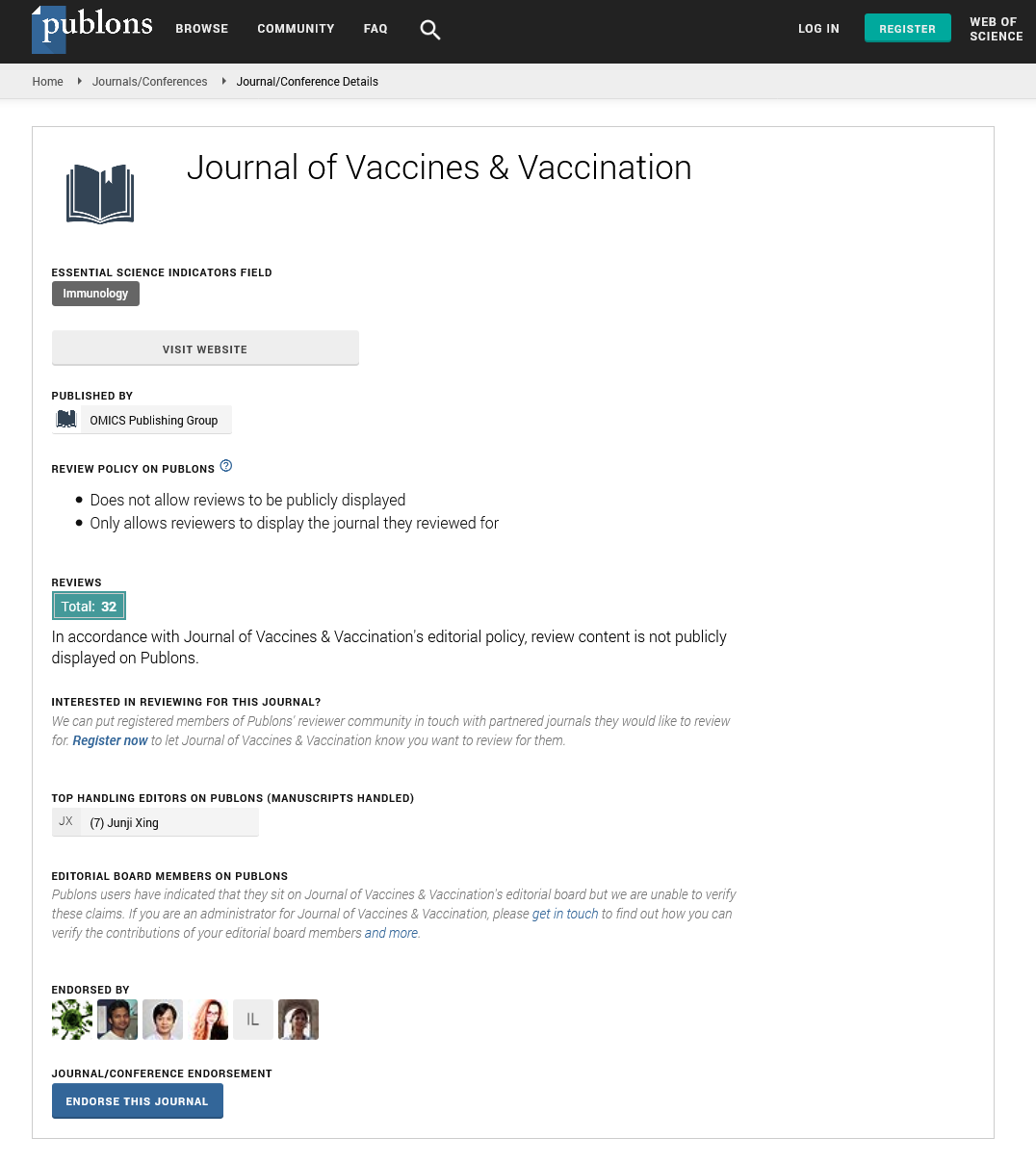Indexed In
- Academic Journals Database
- Open J Gate
- Genamics JournalSeek
- JournalTOCs
- China National Knowledge Infrastructure (CNKI)
- Scimago
- Ulrich's Periodicals Directory
- RefSeek
- Hamdard University
- EBSCO A-Z
- OCLC- WorldCat
- Publons
- MIAR
- University Grants Commission
- Geneva Foundation for Medical Education and Research
- Euro Pub
- Google Scholar
Useful Links
Share This Page
Open Access Journals
- Agri and Aquaculture
- Biochemistry
- Bioinformatics & Systems Biology
- Business & Management
- Chemistry
- Clinical Sciences
- Engineering
- Food & Nutrition
- General Science
- Genetics & Molecular Biology
- Immunology & Microbiology
- Medical Sciences
- Neuroscience & Psychology
- Nursing & Health Care
- Pharmaceutical Sciences
Perspective - (2022) Volume 13, Issue 12
Vaccination for Bacterial Disease: Pertuassis Infection
Wang Yuie*Received: 21-Nov-2022, Manuscript No. JVV-22-19419; Editor assigned: 23-Nov-2022, Pre QC No. JVV-22-19419 (PQ); Reviewed: 07-Dec-2022, QC No. JVV-22-19419; Revised: 16-Dec-2022, Manuscript No. JVV-22-19419 (R); Published: 26-Dec-2022, DOI: 10.35248/2157-7560.22.13.500
Description
Whooping cough (pertussis) is caused by Bordetella pertussis, an acute respiratory infection characterized by severe, spasmodic coughing episodes during the paroxysmal phase. During this stage of the illness, leukocytosis with lymphocytosis is also common. Bronchopneumonia and acute encephalopathy are both dangerous complications. A milder form of pertussis can be caused by Bordetella pertussis. Bordetellae are aerobic, Gramnegative Coccobacilli. Pertussis toxin, adenylate cyclase toxin, filamentous hemagglutinin, and hemolysin are all produced by Bordetella pertussis. Antigens such as agglutinogens and other outer membrane proteins are important. Bordetella pertussis is a pathogen that causes whooping cough in humans. The use of pertussis whole-cell vaccines in infants and toddlers reduced the bacterium's circulation in the child population and significantly reduced the disease's incidence. However, the vaccine does not provide lifelong immunity; in fact, the bacterium's circulation in the adult population has not been controlled. Adult booster immunization with pertussis a-cellular vaccines, which target the virulence of this bacterium and are thus likely to control it, is now possible.
Symptoms
Initial symptoms include a runny nose, sneezing, and a mild cough that may appear to be a common cold. A low-grade fever is also common. However, the cough gradually worsens. As the patient tries to inhale, they will experience bouts of rapid coughing, followed by the "whooping" sound that gives the disease its common name. Droplets are used for transmission. The bacteria only colonise ciliated cells of the respiratory mucosa and multiply quickly. Bacteremia does not happen. The various toxins' roles in pathogenesis are unknown. The patient's skin may turn blue during the coughing fit. The incubation period for pertussis is typically 7–10 days, but it can last up to a month. The disease can take weeks or months to fully run its course after symptoms first appear. People suffering from whooping cough may experience paroxysms, which are fits of rapid, violent, and uncontrollable coughing. Coughing fits usually last 1 to 6 weeks, but they can last up to 10 weeks. Coughing fits usually worsen and become more frequent as the illness progresses.
Vaccination and Treatment
Although pertussis is susceptible to several antibiotics in vitro, including tetracycline, erythromycin, and chloramphenicol, their efficacy in patients during the paroxysmal phase is not convincing. Treatment with erythromycin, the antibiotic of choice, will eliminate viable B. pertussis organisms from the respiratory tract in a matter of days. However, the treatment has no effect on the progression of the disease.
Human hyper immune pertussis globulin is still used on occasion, but there is no reliable data to back up its efficacy. Additional treatment is symptomatic. The pertussis vaccine is made from smooth forms of the bacteria (phase I) as a killed whole-cell vaccine. Numerous pediatricians have argued that general vaccination with the whole-cell vaccine is no longer justified due to the relatively mild course of disease and the occasional neurologic complications after vaccination. The TDAP vaccine is similar to DTP but contains lower levels of diphtheria and tetanus toxoid. It should also be given to adults who did not receive it as children or teenagers. The vaccine is also recommended for all pregnant women during the second half of their pregnancy, regardless of whether they have previously received the vaccine or when it was last administered. Getting the vaccine is especially important for people who have close contact with infants because whooping cough can cause severe and potentially fatal complications in babies.
Citation: Yuie W (2022) Vaccination for Bacterial Disease: Pertussis Infection. J Vaccines Vaccin. 13:500.
Copyright: © 2022 Yuie W. This is an open-access article distributed under the terms of the Creative Commons Attribution License, which permits unrestricted use, distribution, and reproduction in any medium, provided the original author and source are credited.

